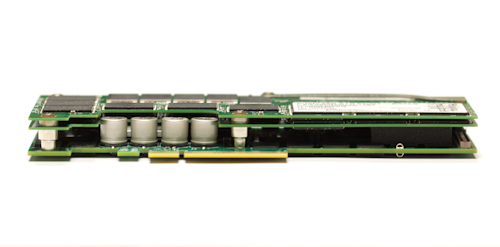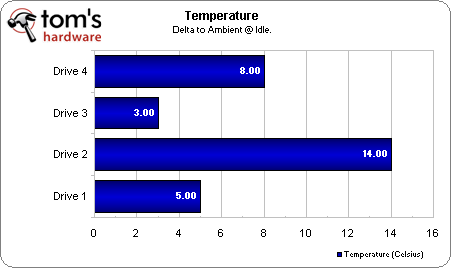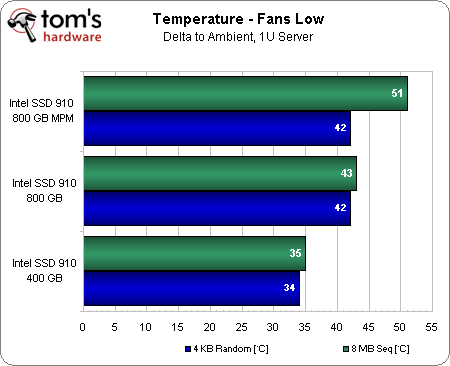Intel SSD 910 Review: PCI Express-Based Enterprise Storage
PCIe-based SSDs have evolved rapidly, with companies like Fusion-io, LSI, and OCZ leading the way. Intel is betting that its reputation for quality and reliability in the enterprise sector are enough to overcome that head-start as it launches SSD 910.
Temperature
One issue that PCIe-based SSDs face is thermal management. The SSD 910 is a very compact card, which means it requires adequate cooling. Intel is very upfront about what it takes to cool this card. In Default mode, 200 LFM is required, while Maximum Performance mode necessitates 300 LFM.
To test the drive's thermal performance, we used a 1U server from Supermicro that provides cooling typical of what we'd expect from most other 1U servers. The tests were performed with the machine set to use its high and low fan settings, which should give us results at both extremes.
Each of the four 200 GB modules has its own temperature sensor. We used the Intel Data Center Tool to record thermal data. Each sensor is at a different location on the board and subject to different amounts of airflow, giving us different results. The graph below shows the delta between the four sensors at idle.
Even at idle, the temperature sensor for drive two is 11oC above the coolest sensor, and 5oC above the next-warmest sensor.
In the following test, only the data from that hottest drive-two is being used.
With the chassis fans at high, the SSD 910 reaches 25oC above ambient, worst-case. The coolest sensor topped out at 10o C above ambient. You can see that there is very little difference between the Default and Maximum Performance modes. So, if you have adequate cooling in your system, you shouldn’t have to worry too much about the extra 3 W that the Maximum Performance mode draws. The 400 GB version is even more conservative, giving off thermal readings between 7 and 20o C above ambient.
You need to pay more attention when the server's fans are set to low, though: the 800 GB SSD 910 gets up to 51o C hotter than ambient in Maximum Performance mode! Plagued by poor airflow, Maximum Performance mode causes the temperatures to soar during sequential writes. Even the coolest sensor still reports 17o C above ambient. If your company's server room runs hot, you'll end up pushing this drive very close to its thermal limits.
Get Tom's Hardware's best news and in-depth reviews, straight to your inbox.
As an aside, we ran the same tests in a pedestal chassis. Although we didn't generate charts with the data, it's worth noting that the SSD 910 performed nearly identically as the 1U server with its fans set to low. And that's with the freestanding enclosure's fans set to high and no add-in cards next to Intel's SSD. In the same chassis with its fans set to low, the SSD 910 reached its thermal cutoff of 85o C in Maximum Performance mode. If you plan on using this drive in a workstation, it would be wise to limit the number of adjacent cards and look into using a slot cooler.
Of course, in the interest of completeness, setting our server's fans to low doesn't generate enough airflow to meet Intel’s requirements, even in a server. That test scenario was intended to demonstrate the importance of knowing the state of your server's cooling configuration. Airflow requirements need to be taken seriously.
Current page: Temperature
Prev Page Power Consumption Next Page Is Intel's SSD 910 Right For Your Enterprise Application?-
that is one fast Sequential read speed. It to bad that they will be $1000+ market and out of reach of all but the server/ workstation crowdReply
-
The OCZ is tested with compressible data? talk about best case scenario. what were the incompressible results like?Reply
-
s3anister PCI-E Solid State Storage is great but I can't help but wonder; where is the Memristor? The true performance gains to be had are with massive RAM-disks that aren't volatile.Reply -
apache_lives The most important and un-comparable factor here is 5 years later those Intel SSD's will still be functional, any other brand im surprised they last 5 months in normal machines with the failure rates i have seen first hand - OCZ, GSkill etc there all horrible i bought an Intel SSD for this reason - THEY WORK.Reply
Review sites never cover real world use - that is to live with it day in day out (reliability), its not all about raw speed and performance. -
ZakTheEvil Yeah, consumer SSD reliability is a bit of disappointment. At best they seem to be as reliable as hard drives.Reply -
georgeisdead This is a note to address several articles I have come across lately that state intel's reputation for quality and reliability in the SSD market as if it is a given. These comments are from my personal experience with intel's drives. I have owned 3 intel solid state drives, one X25-M G1, and two X25-M G2's. The X25-M G1 failed after 2 years while one of the G2 drives failed after 2.5 years. Now, I am not an expert on MTBF and reliability, but in my opinion this is a pretty poor track record. It is entirely possible that this is a coinicidence, however both drives failed in the same manner, from the same problem (determined by a third party data recovery specialist): Bad NAND flash.Reply
As best I understand it as it was descibed by the company that analyzed these failed drives, a block of NAND flash either went bad or became inaccessible by the controller rendering the drives useless and unable to be accessed by normal means of hooking it up to a SATA or USB port. Two drives, different NAND (50 nm for the G1 and 34 nm for the G2), same failure mode.
Once again, this is not definitive, just my observations but to me, I think review sites need to be a little more cautious about how they qualify intel's reputation for quality and reliability because from my perspective, intel has neither and I have since began using crucial SSD's. Hopefully, I will see much longer life from these new drives. -
jdamon113 I would like to see something like this stacked in our EMC, Could this drive with a rack of othere just like it, run 24/7 for 3 + years, Sure we replace a drive here and there in our EMC, but the unit as a whole has never went down in its 5 year life.Reply
Intel, you should test these drive in that real world application. EMC, VM-ware and several data bases carve out some LUN's and Push the envelope. In this situation, should the device prove worthy, the 4000 price tag will come down very fast, and the data center will put it trust in product, So for those reading this for your personal home workstation and gaming ridge, you need not apply in this arena.
Intel is just about 18-months 2 years of owning the data center, Even EMC is powered by intel. -
jaquith Enterprise e.g. SQL you need SLC otherwise you'd be making a career replacing drives. The cost is down time and replacement. I can write more 'stuff' but it's that simple. For our IDX and similar read data it about reliability and capacity.Reply -
willard razor7104that is one fast Sequential read speed. It to bad that they will be $1000+ market and out of reach of all but the server/ workstation crowdThat's because this was not designed for consumers. It's not like they're marking the price up 1000% for shits and giggles. Enterprise hardware costs more to make because it must be much faster and much more reliable.Reply
This drive, and every other piece of enterprise hardware out there, was never meant to be used by consumers. -
drewriley jimbob rubaeThe OCZ is tested with compressible data? talk about best case scenario. what were the incompressible results like?Reply
Check out the Sequential Performance page, lists both compressible and incompressible. For all the other tests, random (incompressible) data was used.




